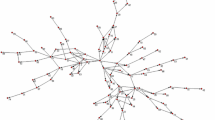Abstract
In this paper, we employ an agent-based industry simulation model to study the effects of the interplay between individual firms’ market evaluation strategies on the extent of product innovations and overall industry development. In particular, we show that a homogenous industry consisting of companies with focus on historical profits yields high overall industry profits but is very unstable. The introduction of a single firm oriented towards market growth rather than profits is sufficient to trigger a severe drop in profits and a transformation towards an industry with strong market growth orientation and a large number of marketed product innovations. Furthermore, we show that the degree of horizontal differentiation of product innovations from existing products is of significant importance for the individual incentives to adopt market growth orientation and the effects of such a development on overall industry profits.
Similar content being viewed by others
References
Armstrong, J.S. and Brodie, R.J. (1994). Effects of portfolio planning methods on decision making: experimental results. International Journal of Research in Marketing, 11, 73–84.
Bayus, B.L. (1997). Speed-to-market and new product performance trade-offs. Journal of Production and Innovation Management, 14, 485–497.
Beardsley, G. and Mansfield, E. (1978). A note on the accuracy of industrial forecasts of the profitability of new products and processes. Journal of Business, 51, 127–135.
Boston Consulting Group (1970). The Product Portfolio, Boston, MA.
Bottazzi, G., Dosi, G., Lippi, M., Pammolli, F. and Riccaboni, M. (2001). Innovation and corporate growth in the evolution of the drug industry. International Journal of Industrial Organization, 19, 1161–1187.
Cantner, U. and Pyka, A. (1998). Absorbing technological spillovers: simulations in an evolutionary framework. Industrial and Corporate Change, 7, 369–397.
Christensen, C. (1997). The Innovator’s Dilemma: When New Technologies Cause Great Firms to Fail. Harvard Business School Press, Boston, MA.
Cyert, R.M. and March, J.G. (1963). A Behavioral Theory of the Firm. Prentice Hall, Englewood Cliffs.
Dawid, H. (2005). Agent-Based Models of Innovation and Technological Change. Forthcoming in: L. Tesfatsion, K. Judd (eds), Handbook of Computational Economics II: Agent-Based Computational Economics. North-Holland.
Dawid, H. and Reimann, M. (2003). Diversification: A Road to Inefficiency in Product Innovations?. Working Paper, University of Bielefeld.
Dawid, H., Reimann, M. and Bullnheimer, B. (2001). To innovate or not to innovate? IEEE Transactions on Evolutionary Computation, 5, 471–481.
Dosi, G. (1988). Sources, procedures and microeconomic effects of diversification. Journal of Economic Literature, 26, 1120–1171.
Fagerberg, J. (2003). Schumpeter and the revival of evolutionary economics: an appraisal of the literature. Journal of Evolutionary Economics, 13, 125–159.
Fagiolo, G. and Dosi, G. (2003). Exploitation, exploration and innovation in a model of endogenous growth with locally interacting agents. Structural Change and Economic Dynamics, 14, 237–273.
Hax, A. and Maljuf, N.S. (1983). The use of the industry attractiveness-business strength matrix in strategic planning. Interfaces, 13, 54–71.
Jacobson, R. and Aaker, D. (1985). Is market share all that it’s cracked up to be? Journal of Marketing, 49, 11–21.
Jovanovic, B. and MacDonald, G.M. (1994). The life cycle of a competitive industry. Journal of Political Economy, 102, 322–347.
Klepper, S. (1996). Entry, exit, growth, and innovation over the product life cycle. American Economic Review, 86, 562–583.
Klepper, S. (1997). Industry life cycles. Industrial and Corporate Change, 6, 145–181.
Kotler, P. (1997). Marketing Management, 9th edn. Prentice Hall.
Malerba, F. (1992). Learning by firms and incremental technical change. Economic Journal, 102, 845–859.
Malerba, F., Nelson, R., Orsenigo, L. and Winter, S. (1999). “History-friendly” models of industry evolution: The computer industry. Industrial and Corporate Change, 8, 3–40.
Morrison, A. and Wensley, R. (1991). Boxing up or boxed in? A short history of the Boston Consulting Group share/growth matrix. Journal of Marketing Management, 7, 105–129.
Nelson, R. and Winter, S.G. (1982). An Evolutionary Theory of Economic Change. Harvard University Press, Cambridge, MA.
Pajares, J., Lopez, A. and Hernandez, C. (2003). Industry as an organization of agents: Innovations and R&D management. Journal of Artificial Societies and Social Simulation, 6, < http://www.soc.surrey.ac.uk/JASSS/6/2/7.html > .
Silverberg, G. and Verspagen, B. (1994). Collective learning, innovation and growth in a boundedly rational, evolutionary world. Journal of Evolutionary Economics, 4, 207–226.
Simon, H. (1978). Rationality as process and as product of thought. American Economic Review, 68, 1–16.
Simon, H. (1983), Reasons in Human Affairs. Stanford University Press, Stanford.
Wind, Y. and Mahajan, V. (1981). Designing product and business portfolios. Harvard Business Review, 59, 155–165.
Wind, Y., Mahajan, V. and Swire, D.J. (1983). An empirical comparison of standardized portfolio methods. Journal of Marketing, 47, 89–99.
Winter, S. (1984). Schumpeterian competition in alternative technological regimes. Journal of Economic Behavior and Organization, 5, 287–320.
Yildizoglu, M. (2002). Competing R&D strategies in an evolutionary industry model. Computational Economics, 19, 51–65.
Author information
Authors and Affiliations
Corresponding author
Rights and permissions
About this article
Cite this article
Dawid, H., Reimann, M. Evaluating Market Attractiveness: Individual Incentives Versus Industry Profitability. Comput Econ 24, 321–355 (2005). https://doi.org/10.1007/s10614-005-6158-z
Accepted:
Issue Date:
DOI: https://doi.org/10.1007/s10614-005-6158-z




